Top 10 States With the Worst Public Tap Water in the United States
Posted by Kenton Jones on Dec 12th 2023

When the water crisis of
Flint, Michigan, hit national headlines a few years ago, U.S. water quality became a topic of national conversation. But as recent research shows, Michigan isn’t the only state dealing with dangerous water.
One-fourth of Americans currently receive water from a source that violates the Environmental Protection Agency's (EPA's) Safe Drinking Water Act. Violations range from inadequate testing to dangerous levels of contaminants like arsenic or lead. And these violations occur across the country, from rural counties to crowded cities.
While unsafe water flows across the nation, the most-affected areas are often low-income and rural. In part, this is because the latest water treatment technology is expensive — many small water systems find it difficult to keep their water treatment techniques to federal standards.
What states have the worst tap water? We’ve gathered the top 10 states with the worst public water ratings across the country, ranked by the total number of people served with unsafe and hazardous water. If your state is on the list, don’t worry — at the end of the article, we go into methods that you can use to test and improve the quality of your water.
States With The Worst Tap Water:
States With the Worst Tap Water

These states may have beautiful scenery, productive markets, and diverse cultures, but they share one thing in common — hazardous water quality. Here's the top 10 list of poor water quality by state.
10. Puerto Rico
Beautiful Puerto Rico is known for stunning beaches and architecture. But since hurricanes Irma and Maria hit in 2017, living conditions on the island have been bleak.
The storms wreaked
massive damage through the island, shutting down infrastructure and tourism for months. Still, electrical outages and unreliable generators mean that running water isn’t guaranteed and is often discolored and filled with sediment when it does run. The government has warned people to boil it thoroughly for three minutes before using.
As the island continues to recover from the hurricanes, its water conditions are slowly improving as well, in part because of
widespread distribution of water filters. However, many issues remain. Even before the hurricanes, nearly all of Puerto Rico’s water violated federal standards. And in 2019, 410 of Puerto Rico's public water systems violated the EPA's water quality standards, with 112 being serious violators.
 9. Georgia
9. Georgia
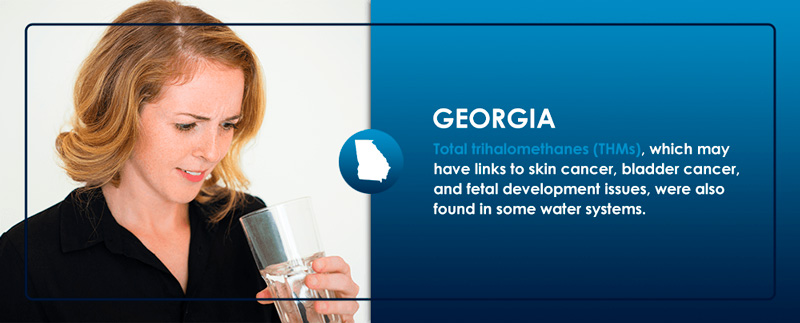
The sunny southern state of Georgia leads the nation in peanut, pecan, and peach agriculture. It's an increasingly important urban center as well — Atlanta is
one of the country’s fastest-growing metro areas, and transplants from around the nation are flocking to the sprawling city.
But the state’s water quality is some of the nation’s worst. With
polluted rivers, streams, and wells, it’s no wonder that much of Georgia’s drinking water doesn’t pass national water quality standards. In some areas, chloroform, radium, bromate, chromium, chlorate, arsenic, or radium levels are well above legal guidelines. Total trihalomethanes (THMs), which may have links to skin cancer, bladder cancer, and fetal development issues, were also found in some water systems. And PFAS and PFOA from thousands of gallons of firefighting foam at Georgia's three military bases have seeped into the groundwater, with some contaminant levels more than 5,000 times the recommended level.
In 2019,
600 of Georgia's public water systems violated the EPA's water quality standards, and 46 were serious violators.
8. Arizona
Arizona sprawls across the deserts and mountains of the western United States. Throughout the region, water is scarce
and growing scarcer — but getting enough water isn’t the state’s only problem.
Arizona tap water is also one of the most dangerous in the nation. According to recent reports, Phoenix tap water has the
highest average levels of chromium-6, a known carcinogen, in the United States. Other toxins linked to cancer and developmental issues, such as perfluorinated chemicals (PFCs), taint the water systems. And as of 2019, nine drinking water systems across the state have tested for higher levels of perfluorooctane sulfonate (PFOS) and perfluorooctanoic acid (PFOA) than permitted by the federal health advisory level. These toxins often come from substances like firefighting foam and household products and are incredibly difficult to remove.
In 2019,
more than 800 of Arizona's public water systems violated the EPA's drinking water standards, and 60 were serious violators.
7. Washington
Washington is known for its nature-loving population, and cities
like Seattle are leading the nation in sustainability. The controversial “raw water” trend is popular in the northern state, and many of its residents make efforts to live eco-friendly lives.
But step outside city limits, and life looks different. Years of historically low snowpack on the Rocky Mountains means the rivers are beginning to run dry. But Washington’s
water crisis isn’t limited to water quantity — the state has some of the nation’s worst water quality.
Arsenic, chloroform, chromium, nitrate, radon, radium, and uranium are
just a few of the contaminants in Washington water, and in many communities, one or more are above the national safety levels. Almost all of the pollutants are known carcinogens, but the chemicals may also lead to developmental issues, liver damage, and reproductive difficulties. In 2019, Washington received a failing grade from the Environment America Research and Policy Center and U.S. PIRG Education Fund for failing to require lead testing in school drinking water.
In 2019,
1,047 of Washington's public water systems violated the EPA's water quality standards, and 112 of those were serious violators.
6. New Jersey
New Jersey is one of the country’s top industrial centers. But the state’s urban sprawl comes with some dangers, including polluted water that leads to its low tap water ranking.
PFCs, which are made up of PFOA and PFOS, are synthetic chemicals used for their grease, water, and heat-resistant properties. However, researchers have realized that PFCs are also highly toxic. Although PFCs are phasing out of production, they continue to persist in water systems and may cause cancer, liver damage, and birth and developmental issues. According to estimates from 2017,
one in five New Jersey residents regularly drinks water contaminated with PFCs.
In 2019, Newark, New Jersey, drew comparisons to Flint, Michigan, when residents had to
line up for bottled water because city-provided filters had failed to keep lead out of the municipal tap water. Other water contaminants, including chlorine, have led to unsafe water exposure for 4.49 million New Jersey residents — over half of the state’s population.
In the same year,
almost 1,400 of New Jersey's public water systems violated the EPA's water quality standards, and 96 of those were serious violators.
 5. Ohio
5. Ohio
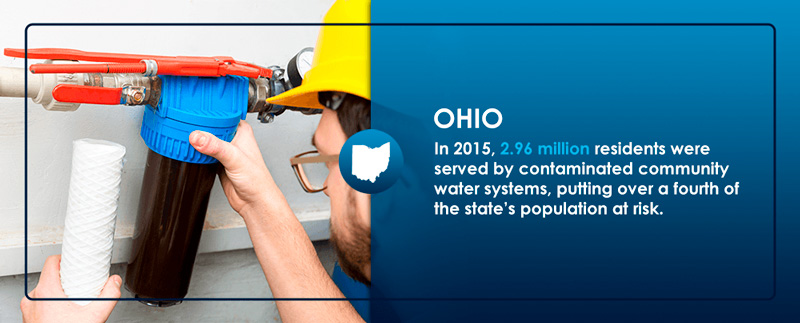
One of America’s industrial centers, Ohio is also one of its most polluted states.
In 2016,
the town of Sebring discovered they had a Flint-like problem — unsafe levels of lead were found in the water system, leading to a brief shutdown of schools and businesses. Since then, conditions have somewhat improved throughout the state. But even low-level childhood exposure to lead can have harmful consequences, including the possible development of seizures, learning disabilities, and behavioral problems.
After years of poor mining practices, many rural Ohio communities live with water that has unsafe levels of iron, sulfate, or other mineral compounds. And Sebring isn't the only Ohio city with hazardous tap water. In 2019,
approximately 1,500 of Ohio's public water systems violated the EPA's water quality standards, and 58 of those were serious violators.
 4. California
4. California
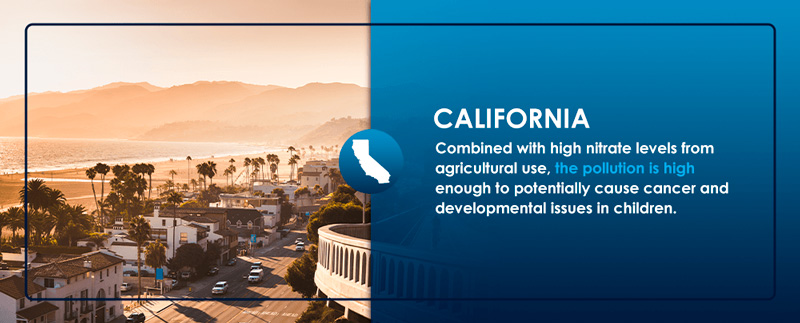
The Golden State is home to warm vineyards and the second-largest city in the country. But it also suffers from polluted water.
Many of California’s rural farming communities are drinking from
arsenic- and uranium-contaminated water systems. Combined with high nitrate levels from agricultural use, the pollution is high enough to potentially cause cancer and developmental issues in children.
In 2019, over 1 million California residents —
more than one in 10 people in 12 counties — received unsafe drinking water. About 1,600 of California's public water systems violated the EPA's water quality standards, and 23 were serious violators.
California’s poor drinking water affects mostly its low-income and rural communities. While the state has started to take action, it may take decades to remediate the drinking water challenges.
3. Florida
The Sunshine State is known for sprawling beaches and world-renowned parks, drawing millions of tourists each year.
But in 2018, the water conditions of Florida faced two ecological emergencies.
Red tide microorganisms drifted into the Gulf of Mexico, and blue-green algae overflowed into rivers, lakes, and the ocean. The combination of both eco-disasters killed large amounts of marine life, and it has turned national attention to the state of Florida’s waters.
An overabundance of fertilizer and other pollutants led to the freshwater algae blooms, which seem to get worse every year. Hurricanes and storms cause floods that send contaminants into the water systems, further damaging the state’s drinking water. In some areas, Florida water has registered
high counts of coliform bacteria from human waste or unsafe levels of copper and lead.
In 2018, the state also delayed informing residents of substantial drinking water contamination with PFOS and PFOA near the Florida State Fire College for
nearly four months. And as of 2019, 1,650 of Florida's public water systems violated the EPA's water quality standards, and 101 were serious violators, impacting their water quality ranking.
2. Pennsylvania
With a rich history and a flourishing job market, the Keystone State is attracting new residents from all corners of the nation. To the casual observer, Pennsylvania’s beautiful countryside, gentle mountains, and diverse cities make it an ideal place to settle. However, Pennsylvania has a long history of water pollution.
Pennsylvania’s economy relied heavily on coal mining for decades. But unregulated mining practices led to a steady flow of pollution, producing black snow and rust-colored streams. Up to 20,000 miles of streams do not meet federal water quality standards for fishing and swimming. Over 200,000 abandoned gas and oil wells dot the landscape, leaching contaminants into groundwater. Along with toxic chemicals, sewage regularly overflows in some areas during hard rains and washes into river systems. And near Philadelphia, about 85,000 residents live in an area where drinking water is unsafe because of PFAS contaminants from firefighting foam at nearby decommissioned military bases.
For some communities, life in rural Pennsylvania has been deeply affected by fracking — a common problem concerns the well water, which can be discolored and odorous. Nearly 6 million Pennsylvanian residents are served with unsafe water systems, and while the state continues to enact new policies, conditions remain largely the same for many small communities.
In 2019, 4,010 of Pennsylvania's public water systems violated the EPA's water quality standards, and 352 were serious violators.
1. Texas
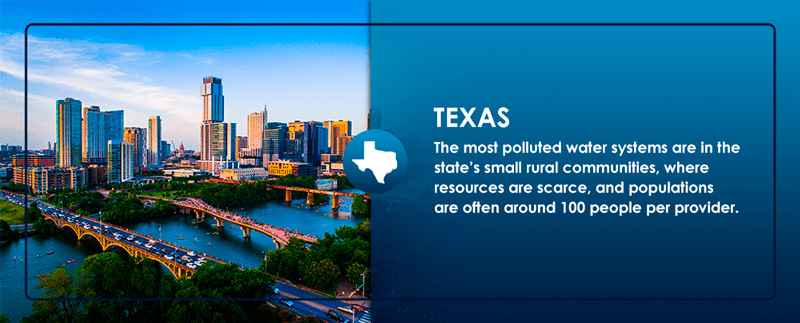
Texas leads the nation with
GDP growth and job creation, but it also tops the list with the worst public water ratings in the United States.
Why is Texas' water so bad? The most polluted water systems are in the state’s
small rural communities, where resources are scarce, and populations are often around 100 people per provider. Lead, radiation, and arsenic are among the top pollutants, partly due to old pipes and water systems, and partly because of contaminants spilled directly into waterways. Almost 500,000 Texas residents also live in areas with contaminated groundwater.
Roughly 12.07 million Texans are served with unsafe water, and the quality doesn’t seem to be improving — the latest reports say that Texas still has
the country’s most radiated drinking water.
In 2019,
3,358 of Texas's public water systems violated the EPA's water quality standards, and 455 were serious violators. All of these factors have led to Texas being ranked the most polluted water in America.
How Can I Find out If My Home Has Poor Water Quality?
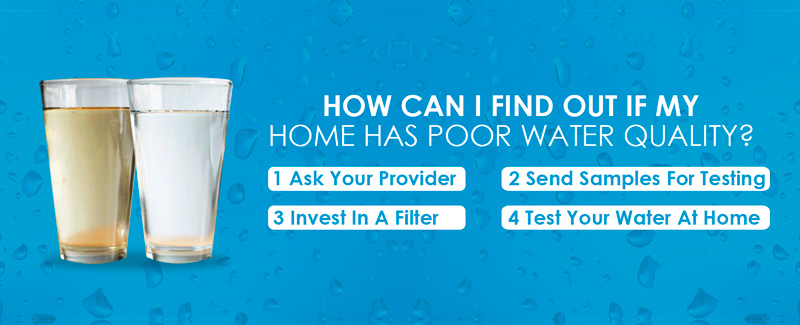
If your state made the list with some of the worst water quality, don’t worry — you can take action to improve your drinking water.
Here are a few steps you can take to determine the safety of your water.
1. Ask Your Provider
Before testing the water yourself, contact your local water provider. All municipalities are required to have water testing done and provide their consumers with the results, whether via mailings or a website post. Look for your municipality's required drinking water report, and get in touch directly if you can't find one.
The report should give you detailed information about the levels of common contaminants such as arsenic, lead, or PFCs. Contacting your provider gives you a valuable starting point — even if you wish to conduct further tests, you will have an idea of what you’re looking for.
2. Send Samples for Testing
For the most trustworthy results, send off a sample of your drinking water to
a certified water-testing laboratory. Experts can run a series of professional tests on your sample, looking for hard-to-detect chemicals such as PFCs.
Typically, laboratories will examine the amounts of chlorine, pesticides, lead, bacteria, and volatile organic compounds in your water, along with pH levels. They can look for other compounds at your request, giving you a thorough report on the quality of your drinking water.
Remember that water quality sampling gives you information only about a single moment in time. Its usefulness is limited since water quality varies from week to week and month to month. Sampling can also become prohibitively expensive because you must pay extra for each additional contaminant you want to test for.
3. Test Your Water at Home
Home testing kits are less precise than professional laboratory testing, but they can provide information about the general state of your water.
You can purchase kits from a variety of different manufacturers, but they all operate similarly — you will take a test strip, expose it to water, and note what color it turns. The kit will come equipped with a color chart matching different tones to different chemicals.
Test your water multiple times to make sure the results are consistent. If any chemical registers in a hazardous amount, contact your local water provider.
Home water testing comes with some of the same caveats as professional water testing. Water quality varies, so a single test, or even a few tests, will give you limited information. Home testing kits are also more limited in what they can test for than professional laboratory testing.
4. Invest in a Filter
The easiest solution is to invest in a water filter. You can avoid most toxins and contaminants with a high-quality water filter. And you'll gain the peace of mind of not having to worry about varying water quality or about whether you've tested for the right contaminants.
Not all filters are the same, however. Some can reduce concentrations of only a few contaminants, while others can address many more. The best and most practical way to reduce pollution in your drinking water is through
a carbon block filtration system. Using microscopic filtration technology, carbon block filters cleanse your water of many impurities without requiring you to re-route your water supply.
From
whole-house systems to small models that sit on your countertop, carbon block filters come in a wide range of sizes and designs so you can find the option that best suits your home.
Clean Water You Can Trust
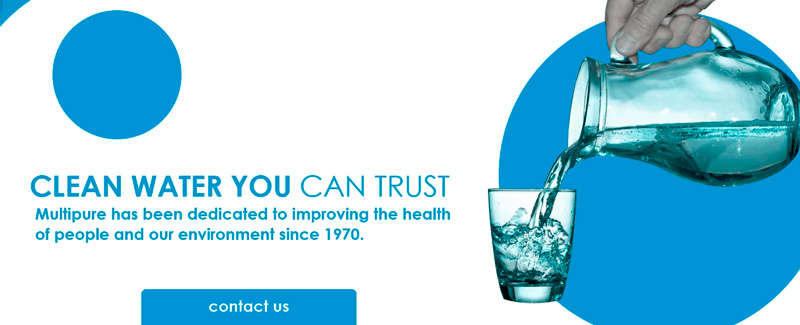
Multipure has been
dedicated to improving the health of people and our environment since 1970. We believe that all Americans should have access to the cleanest, safest water available, regardless of where they live, and we have systems that will work for every budget. Multipure’s
range of carbon block filters will protect you from cysts, bacteria, viruses, and toxic chemicals. Our products have received NSF International certification, so you can trust their quality and reliability.
Look through
our collection of filters and drinking water systems for a solution to your home’s water quality, and feel free to contact us with any questions. Shop our line of water filtration products today including the Aqualuxe, Aquaperform, Aquaversa, and Aquamini.

